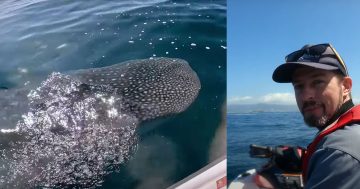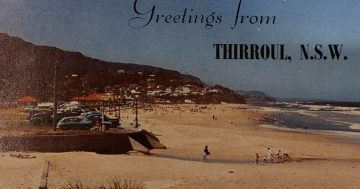
Augustus Earle’s watercolour – The Five Islands District, Illawarra, N.S.Wales (1827). It’s the earliest dateable image of the Illawarra. Earle broke his leg scrambling up the escarpment trying to get back to Sydney. Photo: Mitchell Library, State Library of NSW.
The Five Islands off the Illawarra coast are today known as Flinders Islet, Bass Islet, Martin Islet, Big Island and Rocky Islet.
But these official names were only bestowed upon those five rocks girt by sea as recently as 1953.
Long before that they had some serious naming issues.
Collectively they were called either The Five Islands or The Tom Thumb Islands but local usage over the years has added many more names than there are islands.
Flinders Islet (2.73 ha) and Bass Islet (2.63 ha) are to the north and in 1953 the Boy Martin (who sailed with Bass and Flinders in the Tom Thumb II) scored Martin Islet (2.33 ha).
But Flinders Islet was once known as both Toothbrush Island (because of its appearance) and also as Wollongong Island because it was the closest of the five to Wollongong.
Pleasingly, however, even as late as 1976 the Canberra Times was still calling it Toothbrush Island when writing a story about a Dapto man missing at sea.
Big Island (its official name since 1953) was once known as both Perkins Island and Rabbit Island.
Edward Perkins and his family are recorded as living on the island from 1867 and are supposed to have survived for some five or so years by catching sharks and producing shark oil.
Shark liver oil, as a folk remedy, had long been claimed to promote the healing of wounds and was also a supposed remedy for respiratory tract and digestive system problems.
A principal component (up to 90 per cent) of the oils of many shark livers is squalene – a triterpenoid (C30H50) which, depending on the species, can be from 5–10 per cent of a shark’s total body weight.

A photo taken by L A Lyons of part of Perkins Island (now known as Big Island) as seen in 1950.
But, so his family didn’t starve, Perkins seems to have introduced both rabbits and goats to the island. There survives documented evidence of the impact of grazing on Big Island and a 1938 study titled Notes on the Terrestrial Ecology of the Five Islands considered that significant erosion may have also occurred prior to European settlement.
Because of the long toothbrush-looking handle on the island formerly known as Toothbrush, I have even seen maps on which today’s Big Island (17.8 ha) is recorded as having two parts – Big Island 1 and Big Island 2.
Amusingly, however, even the spelling of Perkins Island – let alone calling it Toothbrush – was contested by a woman claiming to be a descendant of the eponymous family who believed the spelling should have been “Parkyns Island” rather than Perkins.
The smallest of the islands, often barely visible at high tide or in a big sea, is now officially known as Rocky Islet (0.5 ha). But it was once listed on admiralty maps simply as “foul ground”.
Bass Island also proved pretty foul in October 1894 when “Mr C Kingman and Mr W McRae, son of Mr Donald McRae, blacksmith” went on a fishing excursion in a boat called the Sea Spray.
“They were just about to cast their lines when a sudden gust of wind struck the mainsail and carried the boat at lightning speed towards the rocks … within a very few seconds another gust of wind, stronger by far than the first, struck the boat, and simultaneously an enormous wave lifted it mountain-high and landed it with great force on the rocks. The occupants … found themselves alone on a rocky island on which, within the memory of the ‘oldest inhabitant’, human foot had ne’er been planted …”.
The boat soon began to break up and the castaways then set fire to it to attract attention.
While waiting to be rescued they wandered about the island, “which they found to be almost destitute of vegetation – with the exception of a profusion of Scotch thistles and Bathurst burrs.”
Fortunately, their fire did attract attention. The pair were rescued by the Wollongong Pilot and an additional puzzle about the nomenclature of the so-called “Pig Island” was also solved.
In the early 1890s, today’s Bass Island – the most easterly of the five – was briefly known as Pig Island.
Kingman and McRae, however, had found no evidence of the pig and surmised that what had been seen must have been a seal rather than anything porcine.
The real puzzle for me, however, is precisely when does an “islet” get big enough to be called an “island”? I’d also love to know if any Indigenous names for the islands have survived in oral rather than written tradition.

















